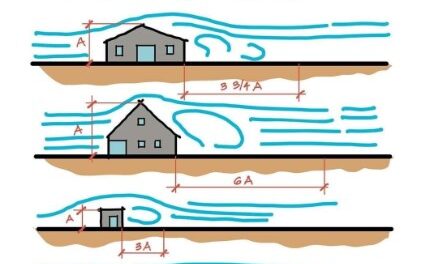
Understanding Wind Flow Patterns for Optimized Home Ventilation
Wind Flow-Based Home Ventilation Optimization

Creating homes that save energy and are kind to the environment involves clever use of the wind. By figuring out how wind moves and using it to our advantage, we can make houses that not only stand up to the weather but also provide a fresh and pleasant living space. This guide breaks down the essentials of using wind patterns to benefit your home.
Firstly, understanding wind pressure is vital. Wind pressure is the force exerted by the wind on a structure. Knowing how to calculate this force is crucial for designing a home that can withstand windy conditions without compromising on comfort. Tools like wind load calculators make this task easier, helping designers and homeowners make informed decisions.
Next, good ventilation is a game-changer for home comfort. Not just about opening windows, but smartly guiding the natural breeze through your home to keep it cool and fresh. Advanced ventilation systems, such as the Honeywell whole house ventilation control, can significantly improve air quality indoors. These systems manage the flow of air throughout the house, ensuring that every room is well-ventilated and comfortable.
Moreover, how a house is positioned plays a significant role in harnessing wind effectively. A house aligned with the natural wind patterns can naturally stay cool in summer and warm in winter, reducing the need for artificial heating and cooling. This not only saves energy but also reduces utility bills.
The Science of Wind Load on Buildings:
When it comes to designing and constructing buildings, one of the key elements that engineers and architects focus on is wind load. This term might sound complex, but it simply refers to the impact that wind has on a building. Imagine the wind pushing against a structure; the force it applies is what professionals call wind load. This force can vary greatly depending on where you live, the shape of your building, its size, and how it’s positioned in relation to the direction the wind usually comes from.
Why is wind load so important? Well, it’s all about making sure buildings are safe, stable, and comply with local building regulations. Engineers use local weather data, consider the building’s dimensions, and its orientation to calculate how much wind pressure it can withstand. This is where a wind load calculator comes into play. It’s a handy tool that helps estimate the wind’s force on a structure, guiding designers and builders in creating buildings that not only stand up to wind but also adhere to safety standards.
For anyone in the building process, whether you’re a homeowner planning your dream house or a builder working on a new project, understanding wind load is crucial. By using a wind load calculator, you make informed decisions, ensuring your building is designed not just for aesthetics but also for durability against the wind. This smart approach to construction not only keeps buildings safe but also aligns with the essential codes and standards, making wind load consideration a cornerstone of responsible building design.
Optimizing House Orientation for Wind Mitigation:
The orientation of a house is pivotal in mitigating the impact of wind loads and harnessing natural ventilation. Proper house implementation can significantly reduce the energy consumption needed for heating and cooling. For instance, orienting a home to take advantage of the summer breeze can enhance natural cooling, while minimizing exposure to harsh winds can reduce heating costs in the winter.
Ventilation: A Cornerstone of Healthy Living Spaces:
Ensuring good ventilation in your home is key to keeping the air clean and fresh, which is vital for a healthy living environment. Stale air, excess moisture, and indoor pollutants can quickly accumulate without proper airflow, leading to health issues and discomfort. This is where advanced ventilation solutions come in, particularly whole house ventilation systems like those offered by Honeywell.
Honeywell’s whole house ventilation control systems are at the forefront of improving indoor air. By pulling in fresh air from outside and circulating it throughout your home, these systems help to continuously replace stale, polluted indoor air with cleaner outdoor air. This not only helps to reduce moisture levels and pollutants but also ensures that your living space remains comfortable and healthy.
What sets these systems apart is their ability to adjust to the specific climate you live in and cater to your personal preferences. Whether you’re dealing with a humid summer or a dry winter, a whole house ventilation system can be programmed to maintain the optimal air quality for your home. This level of customization is a significant advancement in home ventilation technology, making it easier than ever to manage your home’s air quality effectively.
Incorporating a Honeywell whole house ventilation system is a smart move for anyone looking to enhance their living space’s health and comfort. By embracing this technology, you’re not just improving your home’s air quality; you’re investing in the well-being of everyone who lives there.
Design Strategies for Improved Airflow:
Improving the airflow in your home doesn’t have to be complex or costly. By adopting a few smart design strategies, you can ensure your living spaces are not only comfortable but also energy-efficient. Here’s how to make the most of natural ventilation:
1. Cross Ventilation: Let the Breeze Flow Through
Imagine a gentle breeze wafting through your home, from one side to the other. That’s cross ventilation for you. By smartly placing windows and doors across from each other, you create a path for the wind to flow straight through your home. This method is simple but effective in keeping your space cool and fresh without relying heavily on air conditioning.
2. Stack Ventilation: Harness the Power of Rising Heat
Heat naturally rises, and stack ventilation takes advantage of this. By opening lower windows or vents and having openings higher up, like upper windows or vents, you create a natural circulation. Warm air exits through the top, pulling cooler air in from below. This natural process helps in maintaining a pleasant temperature inside, reducing the need for mechanical cooling systems.
3. Windbreaks: Guide the Wind Your Way
- Sometimes, the wind needs a little guidance to flow where you want it. Windbreaks can be your solution. By strategically planting trees or building barriers, you can shield your home from harsh winds while directing the breeze to areas that need ventilation. This not only protects your home from potential wind damage but also ensures that fresh air is delivered exactly where you need it.
Whole House Ventilation Systems:
A whole house ventilation system is a strategic addition to any home, ensuring that external air can refresh the indoor environment. This system works by extracting stale air from inside and replacing it with filtered, fresh air from outside, which can be particularly beneficial for homes in urban areas or regions with high pollen counts.
Ventilation Strategies:
Understanding how wind moves around your home can really help make it more comfortable and fresh inside. When designing a house, knowing where the wind tends to push harder (high-pressure areas) and where it eases up (low-pressure areas) lets you figure out the best spots for windows, vents, and doors. This way, you can get the most air flowing through your home, which is great for keeping it cool and getting rid of stale air. Adding in technology, like the Honeywell system for controlling ventilation throughout the whole house, makes it even better.
But it’s not just about making sure your house stands up to the wind. Thinking about how the wind affects your home helps make sure it’s a place that’s good for the planet, feels good to live in, and is healthy, too. Using special calculators to see how the wind will hit your home, choosing the right direction for your house to face, and picking out a whole-house ventilation system are all steps towards a home that’s modern, eco-friendly, and just plain nice to be in. Architects and homeowners who use both nature’s breeze and smart systems are leading the way in making homes that are ready for the future, combining the best of both worlds for living spaces that are comfortable, sustainable, and healthy.
